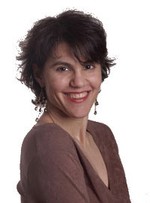Teenage Waistland by Abby Ellin

Abby Ellin
Abby Ellin, a journalist and former fat-camper whose parents’ attempts to “save her” from fatness proved counterproductive, has had a lifelong interest in figuring out how they might have done it better, and an abiding compassion for overweight kids. In Teenage Waistland, she shares the story of her own adolescent struggle with food and weight, and journeys with hope, skepticism, and humor through the landscape of today’s diet culture.
She visits camps and community programs, and talks to experts, kids and their parents, seeking to answer these questions: What can parents say that kids will hear? Why don’t kids exercise more and eat less when they’re dying to be thinner? What treatment methods actually work? Willpower, or surrender? Shame, or inspiration? Teenage Waistland is ultimately clarifying and provocative for anyone who’s ever wrestled with weight issues. One size does not fit all when it comes to weight loss, and the better we understand that, the more likely we are to be able to help our kids.
EXCERPT:
Most of us know that, at its core, losing weight is a physiological process. You ingest fewer calories, you lose pounds. Period. If psychology-and, to a certain extent, biology-didn’t enter into the picture, of course, we’d all be thin. The beauty of the fat camp is that it is an environment that eliminates psychology and free will and focuses mostly on the physiological piece: an artificial universe where every meal is pre-prepared, regulated, and monitored. It is almost-but not completely-impossible to deviate from the rules. If you stick to the program, you will lose weight. That, at least, is the hope of campers and their parents: that fat camp will be a one-time fix, and that the camper will lose enough weight in one pop to be motivated to stay thin forever; that it will provide a crash course in nutrition-or, at least, a two-month hiatus from weight gain, giving everyone involved a respite from the anxiety and battles.
But what fat camp doesn’t address are the emotional and familial components that contribute to obesity-at least, not in any real way. Camps provide technical information on weight loss, but they don’t adequately address the emotional issues. For most kids-for most people-technical information isn’t enough.
When you step on the grounds of a fat farm, the outside world ceases to exist. Everything shifts out of balance, size becomes relative, and objects in the mirror are usually larger than they appear. You don’t realize it, though. Stephanie calls it “fat goggles”-an apt description for the unique optical illusion created at fat camp. When you’re surrounded by people who weigh 200, 250 pounds, everything seems small in comparison. Those who weigh 180 are at the lighter end of the spectrum; a 160-pounder is downright slender. A fat farm is also a place where the extra flab on your body no longer distinguishes you from the crowd. Call out “Hey, Fatso!” and fifty people are going to turn around. There’s something comforting about this, camaraderie I imagine war veterans understand.
When I was fifteen my grandfather died, leaving me a sizable inheritance. I decided to spend some of the extra cash on a weight loss camp, or food rehab, as I liked to think of it.
An acquaintance of mine lost twenty-five pounds at Camp Colang and looked great. Never mind that three months later she’d gained it all back, plus ten. I knew that the only place I’d ever get thin was somewhere without an easily accessible bulk-food section, where there were other people trapped in the same miserable, oversized barge. It seemed perfect, a haven for “overweight men and women to make good friends and build self-esteem in the heart of the pines and the Poconos,” as the brochures used to say. Sure, it was expensive-about $3,500 for nine weeks, money I could have put toward college-but I thought it was worth it, and I happily forked over the cash.
ABOUT THE AUTHOR: For five years, Abby Ellin wrote the “Preludes” column, about young people and money, in the Sunday Money and Business section of the New York Times. She also regularly writes the “Vows” column in the New York Times Sunday Styles section, as well as feature assignments for the New York Times Magazine. Her work has appeared in a range of publications, including Time, the Village Voice, Marie Claire, More, Self, Glamour, the Boston Phoenix, and Spy (RIP). She’s an editor-at-large for Gotham magazine and has an MFA in Creative Writing from Emerson College. But her greatest claim to fame is naming “Karamel Sutra” ice cream for Ben and Jerry’s. Visit her at www.teenagewaistland.com.
